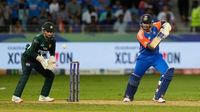The Sheikh Zayed Stadium in Abu Dhabi was awash with anticipation as India, already riding high in the Asia Cup 2025, faced off against Oman in the tournament’s 12th match on Friday, September 19. With a spot in the Super-Four already secured thanks to dominant wins over the UAE and Pakistan, the Men in Blue entered this encounter as overwhelming favorites. Oman, on the other hand, had already been eliminated after tough losses to both Pakistan and the UAE, but were determined to leave a mark in their final group game.
India’s captain Suryakumar Yadav won the toss and, with an eye on maintaining momentum and perhaps giving the middle order some much-needed time in the middle, chose to bat first. “We just want to continue with the good habits we’ve been following over the last two days. Pitch looks really nice. Harshit Rana comes in,” Surya remarked at the toss, referencing a strategic rotation with Harshit getting a nod in the playing XI. Jasprit Bumrah was rested, with Arshdeep Singh and Harshit Rana both featuring, a move that signaled India’s intent to manage workloads ahead of a crucial Super-Four clash against Pakistan.
India’s opening pair, Abhishek Sharma and Shubman Gill, strode out to the middle with trademark confidence. The pair had been in sparkling form throughout the group stage, and Abhishek wasted no time, continuing his aggressive approach. He cracked 38 runs off just 15 deliveries, peppering the boundary with five fours and two sixes before falling to a thin edge off Jiten Ramanandi. Gill, meanwhile, was undone early by a peach from Oman’s Shah Faisal, bowled for just 5 runs as the ball seamed through his defense.
Sanju Samson, promoted to number three, anchored the innings with a measured and patient approach. Early on, he looked scratchy, beaten repeatedly by Oman’s disciplined pacers, but he soon found his rhythm. By the time he reached his half-century—his third in T20Is, and notably his slowest—Samson had weathered the storm and provided stability. He eventually top-scored with 56 off 45 balls before holing out to Aryan Bisht in the deep.
India’s middle order, including Tilak Varma (29 off 18), Axar Patel (26 off 13), and a late flourish from Harshit Rana (an unbeaten 12, including a six off the final ball), ensured the total kept climbing despite regular wickets. Oman’s bowlers, led by Aamir Kaleem and Jiten Ramanandi, kept things tight in patches, with Kaleem snaring two wickets and Jiten finishing with two of his own. A pair of run outs, including the dismissal of Hardik Pandya for just 1, further pegged India back, but the batting depth allowed them to post a formidable 188 for 8 in their 20 overs.
As the teams changed ends, the challenge was clear for Oman: chase down 189 against a potent Indian attack on a surface where the average first-innings total had been around 160 in recent matches. The opening duo of Jatinder Singh and Aamir Kaleem began the reply with composure, negotiating the early threat posed by Arshdeep Singh and Hardik Pandya. Jatinder, Oman’s captain, led by example—cutting, pulling, and driving with authority. He found the boundary with a beautiful cut shot and then ended the Powerplay with an emphatic pull for four, signaling Oman’s intent not to go quietly.
India’s bowlers, with Harshit Rana eager to impress and Kuldeep Yadav in typically menacing form, kept probing. The pitch offered some movement for the pacers early on, and as the innings wore on, the spinners began to extract purchase. Oman’s batsmen, though, showed resilience, with both openers surviving a few close calls—including a concussion check for Kaleem after a top edge ricocheted off his helmet—and capitalizing on any loose deliveries.
Despite Oman’s spirited start, the required run rate loomed large. India’s fielding was sharp, and the bowlers kept varying their lines and lengths. Kuldeep Yadav, already the recipient of two Player of the Match awards earlier in the tournament and boasting seven wickets in just over six overs at an average of 3.57, was expected to play a pivotal role as the chase progressed. The Indian camp, meanwhile, remained focused but relaxed, knowing they had the depth and firepower to close out the game.
Throughout the contest, India’s strategic rotation was evident. With the Super-Four in mind and a blockbuster rematch against Pakistan on the horizon, the team management made sure to give opportunities to players like Harshit Rana and Arshdeep Singh, both of whom looked to stake their claims for a permanent spot. The likes of Suryakumar Yadav and Hardik Pandya took on leadership roles, guiding the younger players through high-pressure scenarios.
For Oman, this match was about pride and experience. Their campaign had been tough—thrashed by Pakistan and outplayed by the UAE—but against India, they showed flashes of the grit and skill that had brought them to the Asia Cup stage. Jatinder Singh’s leadership, both with the bat and in the field, was commendable, and the bowlers’ ability to keep India under 200 was a testament to their discipline and planning.
As the match moved into the second half, the crowd at Sheikh Zayed Stadium remained vocal, urging both sides on. The Indian fans, as always, were in full voice, but there was plenty of support for the underdogs from Oman as well. The energy in Abu Dhabi was palpable, with every run cheered and every wicket greeted with anticipation.
With the outcome still in the balance as Oman’s chase continued, all eyes were fixed on whether India’s bowlers could tighten the screws or if Oman’s openers could engineer a famous upset. The Asia Cup 2025 has already delivered its share of drama, and this contest was shaping up to be another memorable chapter.
As the final overs approached, India’s grip on the match seemed to be firming, but cricket’s unpredictability meant nothing was certain until the last ball was bowled. Fans across the globe tuned in, eager to see if Oman could mount a challenge or if India would march on with another commanding performance. Either way, the stage was set for a thrilling finish in Abu Dhabi.


